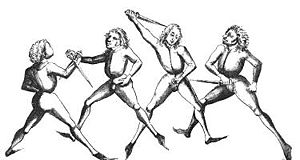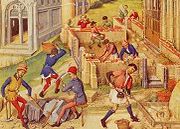.gif)
Rondel (dagger)
Encyclopedia

Dagger
A dagger is a fighting knife with a sharp point designed or capable of being used as a thrusting or stabbing weapon. The design dates to human prehistory, and daggers have been used throughout human experience to the modern day in close combat confrontations...
in Europe
Europe
Europe is, by convention, one of the world's seven continents. Comprising the westernmost peninsula of Eurasia, Europe is generally 'divided' from Asia to its east by the watershed divides of the Ural and Caucasus Mountains, the Ural River, the Caspian and Black Seas, and the waterways connecting...
in the late Middle Ages
Middle Ages
The Middle Ages is a periodization of European history from the 5th century to the 15th century. The Middle Ages follows the fall of the Western Roman Empire in 476 and precedes the Early Modern Era. It is the middle period of a three-period division of Western history: Classic, Medieval and Modern...
(from the 14th century onwards), used by a variety of people from merchant
Merchant
A merchant is a businessperson who trades in commodities that were produced by others, in order to earn a profit.Merchants can be one of two types:# A wholesale merchant operates in the chain between producer and retail merchant...
s to knight
Knight
A knight was a member of a class of lower nobility in the High Middle Ages.By the Late Middle Ages, the rank had become associated with the ideals of chivalry, a code of conduct for the perfect courtly Christian warrior....
s. It was worn at the waist and might be used as a utility tool, or worn into battle
Battle
Generally, a battle is a conceptual component in the hierarchy of combat in warfare between two or more armed forces, or combatants. In a battle, each combatant will seek to defeat the others, with defeat determined by the conditions of a military campaign...
or a jousting
Jousting
Jousting is a martial game or hastilude between two knights mounted on horses and using lances, often as part of a tournament.Jousting emerged in the High Middle Ages based on the military use of the lance by heavy cavalry. The first camels tournament was staged in 1066, but jousting itself did not...
tournament
Tournament (medieval)
A tournament, or tourney is the name popularly given to chivalrous competitions or mock fights of the Middle Ages and Renaissance . It is one of various types of hastiludes....
as a side-arm.
Design and Construction

Steel
Steel is an alloy that consists mostly of iron and has a carbon content between 0.2% and 2.1% by weight, depending on the grade. Carbon is the most common alloying material for iron, but various other alloying elements are used, such as manganese, chromium, vanadium, and tungsten...
, and was typically long and slim with a tapering needle point, measuring 12 inch
Inch
An inch is the name of a unit of length in a number of different systems, including Imperial units, and United States customary units. There are 36 inches in a yard and 12 inches in a foot...
es (30 cm
Centimetre
A centimetre is a unit of length in the metric system, equal to one hundredth of a metre, which is the SI base unit of length. Centi is the SI prefix for a factor of . Hence a centimetre can be written as or — meaning or respectively...
) or more; the whole dagger might be as long as 20 inches (50 cm). Rondel means round or circular
Circle
A circle is a simple shape of Euclidean geometry consisting of those points in a plane that are a given distance from a given point, the centre. The distance between any of the points and the centre is called the radius....
; the dagger gets its name from its round (or similarly shaped, e.g. octagonal) hand guard and round or spherical
Sphere
A sphere is a perfectly round geometrical object in three-dimensional space, such as the shape of a round ball. Like a circle in two dimensions, a perfect sphere is completely symmetrical around its center, with all points on the surface lying the same distance r from the center point...
pommel
Pommel
Pommel may refer to:* pommel, the raised area at the front of an equestrian saddle.* Pommel, the counterweight at the end of the hilt of a European sword* Pommel horse, an artistic gymnastics apparatus...
(knob on the end of the grip).
The blade's tang extended through the handle, which was cylindrical, normally carved from wood or bone. In cross section, the blade was usually diamond
Rhombus
In Euclidean geometry, a rhombus or rhomb is a convex quadrilateral whose four sides all have the same length. The rhombus is often called a diamond, after the diamonds suit in playing cards, or a lozenge, though the latter sometimes refers specifically to a rhombus with a 45° angle.Every...
-shaped, lenticular
Lens (geometry)
In geometry, a lens is a biconvex shape comprising two circular arcs, joined at their endpoints. If the arcs have equal radii, it is called a symmetric lens.A concave-convex shape is called a lune...
, or triangular. These blades would have a sharpened point, and either one or both edges would also be sharpened. They were principally designed for use with a stabbing action, either underarm, or over arm with a reverse grip (think ice pick). They would also have been used for cutting. The long straight blade would not have lent itself to a slashing or sabre
Sabre
The sabre or saber is a kind of backsword that usually has a curved, single-edged blade and a rather large hand guard, covering the knuckles of the hand as well as the thumb and forefinger...
action. Rondel daggers were ideal in battle for puncturing chain mail
Mail (armour)
Mail is a type of armour consisting of small metal rings linked together in a pattern to form a mesh.-History:Mail was a highly successful type of armour and was used by nearly every metalworking culture....
, and although they would not have been able to punch through plate armour
Plate armour
Plate armour is a historical type of personal armour made from iron or steel plates.While there are early predecessors such the Roman-era lorica segmentata, full plate armour developed in Europe during the Late Middle Ages, especially in the context of the Hundred Years' War, from the coat of...
, they could be forced between the joints in a suit of armour and helmet
Helmet
A helmet is a form of protective gear worn on the head to protect it from injuries.Ceremonial or symbolic helmets without protective function are sometimes used. The oldest known use of helmets was by Assyrian soldiers in 900BC, who wore thick leather or bronze helmets to protect the head from...
s. This was often the only way in which a heavily-armoured knight could be killed.
A few examples also exist of four-edged rondel daggers, the blade having a cruciform
Cross
A cross is a geometrical figure consisting of two lines or bars perpendicular to each other, dividing one or two of the lines in half. The lines usually run vertically and horizontally; if they run obliquely, the design is technically termed a saltire, although the arms of a saltire need not meet...
profile. These blades would not have been suited for cutting, or use as a general utility tool; they would have been worn as a side-arm in battle as a thrusting weapon, forshadowing the appearance of the stiletto
Stiletto
A stiletto is a knife or dagger with a long slender blade and needle-like point, intended primarily as a stabbing weapon. The stiletto blade's narrow cross-section and acuminated tip reduces friction upon entry, allowing the blade to penetrate deeply...
in the 16th century. Rondel daggers which have survived and found their way into museums and collections are usually those with fine craftsmanship and often ornate decoration. The blades may be engraved, the grips ornately carved, and the hand guards and pommels highly decorated.
Usage


Plate armour
Plate armour is a historical type of personal armour made from iron or steel plates.While there are early predecessors such the Roman-era lorica segmentata, full plate armour developed in Europe during the Late Middle Ages, especially in the context of the Hundred Years' War, from the coat of...
.
By the 15th century it had become the standard side-arm for knights, and would have been carried into battles such as the Battle of Agincourt
Battle of Agincourt
The Battle of Agincourt was a major English victory against a numerically superior French army in the Hundred Years' War. The battle occurred on Friday, 25 October 1415 , near modern-day Azincourt, in northern France...
in 1415. They were a knight's backup weapon to be used in hand to hand fighting, and as such one of their last lines of defence. Since they were able to penetrate a suit of armour (at the joints, or through the visor of the helmet), rondel daggers could be used to force an unseated or wounded knight to surrender, for a knight might fetch a good ransom.
In the 15th century, the roundel dagger also rose to popularity among the emerging middle class
Middle class
The middle class is any class of people in the middle of a societal hierarchy. In Weberian socio-economic terms, the middle class is the broad group of people in contemporary society who fall socio-economically between the working class and upper class....
. In a scene from a miniature by Girat de Roussillon depicting the construction of twelve churches in France
France
The French Republic , The French Republic , The French Republic , (commonly known as France , is a unitary semi-presidential republic in Western Europe with several overseas territories and islands located on other continents and in the Indian, Pacific, and Atlantic oceans. Metropolitan France...
(c. 1448), merchants and tradesmen can be seen wearing rondel daggers at their waists.
Hans Talhoffer
Hans Talhoffer
Hans Talhoffer was a Fechtmeister , employed as 'master of arms' to the Swabian knight Leutold von Konigsegg, a feudatory of Count Eberhardt the Bearded of Württemberg in southern Germany...
in his combat manuals of the 1440s to 1460s includes numerous examples of techniques for fighting with the roundel dagger, both in unarmed combat and in single combat in armour.
See also
- List of daggers
- List of medieval weapons
- Military technology and equipment
External links
- Spotlight: The Rondel Dagger (myArmoury.com article)
- Website about Talhoffers Fetchbuch
- Overview of Medieval arms and armour - link broken 2005-12-20
- Overview of the 15th century knight's weapons and armor

